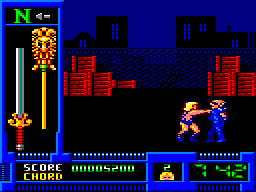
Masters of the Universe: The Movie
(Gremlin Graphics, 1988)
The Cosmic Key has fallen through a time gate and emerged on Earth. He-Man must find the eight chords that make up the key before his arch-enemy Skeletor gets his hands on them. The main section of game involves wandering around a city looking for the chords; you will need to make a map, or you’ll become lost. It also doesn’t help that the orientation of north on the screen changes when you turn at a junction. Occasionally, you will be called to specific locations in the city to play one of a few very easy sub-games. The graphics and music are satisfactory, but wandering around the city is very dull, and the sub-games don’t liven things up that much.
![]() Watch YouTube videos of this game by:
ChinnyVision,
jgonza,
Metr81.
Watch YouTube videos of this game by:
ChinnyVision,
jgonza,
Metr81.
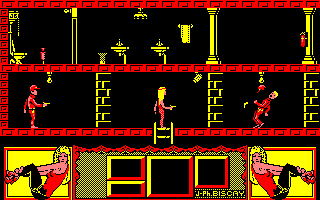
Mata Hari’s lover is locked in the upper floor of an embassy. Fortunately, she’s got what it takes to face all the armed guards, security doors and traps that await inside. Despite being an adventure, the gameplay is relatively simple. There are only a few actions (blow open doors, kill guards, get security codes, etc.) to be performed several times. Despite that, the game is far from boring, and the adjusted level of difficulty makes Mata Hari fun to play and not too difficult to finish. By the way, the ending sequence is not bad.
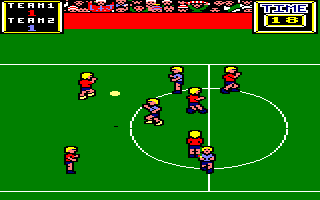
Match Day
(Ocean, 1985)
Play football against the computer or with a friend in this now very dated game, playing either a single game or the Match Day tournament with seven other teams. This may have been a relatively good game back in its day, but it just doesn’t compare well with other football games that were released in later years. The players move very slowly, and so does the ball, and actually getting hold of the ball is frustratingly difficult. One of the worst problems is that the computer never seems to let you control the player nearest to the ball, and instead selects another player who is further away, giving computer-controlled teams an advantage. The graphics are good, with colourful and well animated players, and the music is lovely as well, but it’s best to avoid this game.
See also: Match Day II.
![]() Watch YouTube videos of this game by:
ChinnyVision,
Xyphoe.
Watch YouTube videos of this game by:
ChinnyVision,
Xyphoe.
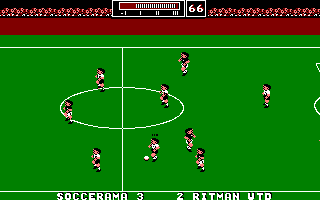
Match Day II
(Ocean, 1988)
The sequel to Match Day is an improvement, but it’s still flawed. The game is now much more customisable; you can choose tactics for your team, the computer’s skill level, and the way your players kick the ball. This last option is related to the introduction of a ‘kickometer’ which lets you judge how hard you want to kick the ball. There is also both a knockout and a league tournament to compete in, and as well as the traditional one- and two-player games, two players can play in the same team, against the computer. Colour has been sacrificed for more detailed graphics, which I like, and the sound of the crowd cheering and playing tunes is a nice touch. However, it’s still slow, and many of the problems associated with Match Day are still present.
See also: Match Day.
![]() Watch YouTube videos of this game by:
jgonza,
Retro Danuart,
Xyphoe.
Watch YouTube videos of this game by:
jgonza,
Retro Danuart,
Xyphoe.
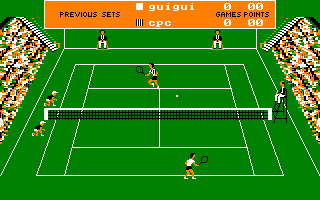
Since tennis games are rare on the CPC, this one (known as Balle de Match in France) is relatively good. Unfortunately, you can’t elaborate a real strategy because you haven’t got any choice in your strikes. All you can do is try to hit the ball, which is often difficult. The more you win matches, the faster your opponents play, and the computer quickly becomes unbeatable. Anyway, it is rather fun to play once you’ve managed to handle your player.
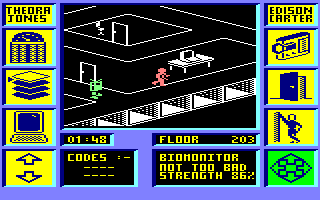
During the 1980s Max Headroom was born. Who is he? Well, Max is credited as being the world’s first computer-generated television host. He rose to fame for a short while as a fictional British artificially intelligent character known for his wit, stuttering and distorted electronically sampled voice. You either loved him or loathed him. As for the game, it’s very uninspiring. You take on the role of TV reporter Edison Carter and you must save Max Headroom from the clutches of TV station Network 23. The gameplay is utter nonsense, running around searching rooms, and the graphics are just completely naff.
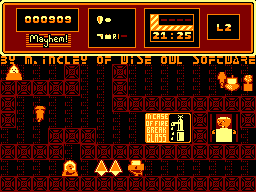
Mayhem
(Kevin Thacker, 2023)
The space pirate Sniggih has placed a nuclear bomb on board the UKS Enterprising, and it is timed to explode in thirty minutes! You have to explore the four decks of the ill-fated spacecraft and find the four digits of the code that will defuse the bomb. To begin with, you don’t have any weapon, so you must find one. You also move around rather slowly, so you’ll also need to find a speed pack to enable you to move faster. Each deck of the ship consists of a large maze, and it is advisable to make a map. This game was originally released by The Power House in 1987 for the ZX Spectrum, where it seems to have been largely forgotten – and for good reasons. The graphics and sound effects are nothing special, and there’s not enough variety in the mazes or the gameplay to keep you wanting to play it for long.
![]() Watch a YouTube video of this game by:
XeNoMoRPH.
Watch a YouTube video of this game by:
XeNoMoRPH.
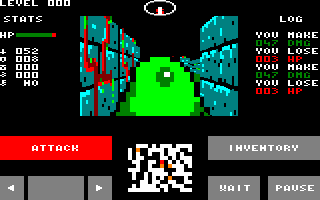
Maze Adventure
(Albert Sirvent Jerez, 2016)
Explore 32 levels of a dungeon and defeat as many monsters as you can in your struggle to escape. It sounds simple enough, but you’ll probably fall asleep or switch your CPC off long before you even make it past the first two levels. This is a dungeon crawl role-playing game which is viewed from a 3D perspective in a similar manner to the likes of Bloodwych. You must wander around each level killing monsters so you can gain experience points and retrieve the key to open the door to the next level. The main problem with this game is that it’s a matter of luck as to how many monsters you must kill before you obtain the key. Also, the 3D rendering of the dungeon takes ages to draw and the game is very slow as a result, and the music is very irritating. The concept is ambitious, but the humble CPC just doesn’t have the power to handle it.
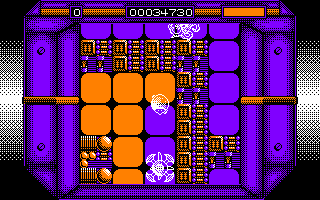
Maze Mania
(Hewson, 1989)
Flippo has to change all of the tiles in each maze to another colour, but there are lots of monsters to avoid! It’s a fun little game with some nice graphics (for the scenery, that is), and reasonable sound effects. There are also lots of power-ups to collect, as well as a chance to get some bonuses at the end of each maze. Unfortunately, Flippo sometimes won’t paint a tile properly, so you have to go back and try again, which can be a bit annoying, but it’s still a lovely game.
![]() Watch a YouTube video of this game by:
Amstrad CPC World.
Watch a YouTube video of this game by:
Amstrad CPC World.
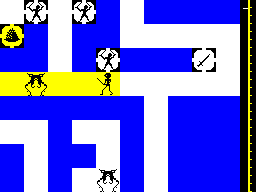
Maziacs is a remake of the classic Spectrum game that was released in 1983. It is an arcade game from the first era of gaming, meaning that it is simple, fast and enjoyable. Personally I was surprised to see it appearing on the CPC after 30 years and I feel grateful to 40Crisis. To begin with, the graphics are basic – not many colours and not too detailed – and the animation is minimal. The sound is also basic, with some effects and nothing else. Now we are getting to the interesting part, the gameplay. It is very fast-paced; the player must be constantly alert! I really enjoyed the atmosphere and the setting of this game; nowhere to run, nowhere to hide inside the mazes, and everything is hunting for you! The grab factor is really high, something that happens with most games of this era (pre-1984). Overall, a great idea that results in a great yet simple arcade game.
